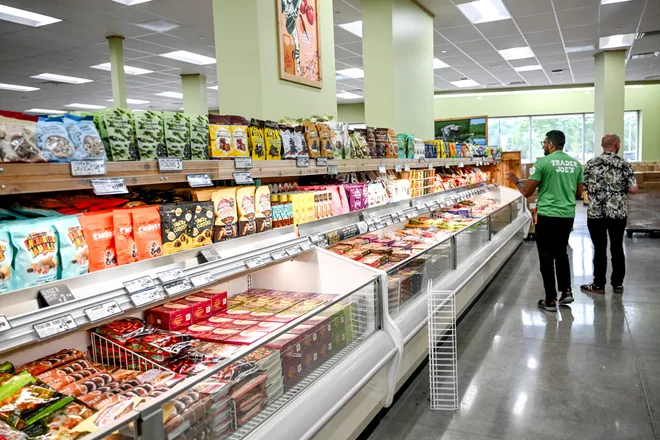Even as inflation cools, Americans report sticker shock at grocery store register
Latasha Warner does everything she can to keep food costs down.
She avoids restaurants. Buys off-brand products. Avoids meat that's not on sale. Travels out of town to shop at bigger, more affordable chains. And still, she says the $200 she spent on groceries Tuesday isn’t enough food to last the week for her, her husband and two children.
Her $17.54-an-hour job in Kentucky leaves her in financial limbo, making too much for financial assistance but not enough for the basics. Groceries take up about half of her paycheck, she said, which makes other expenses ‒ from car repairs to vacations ‒ unaffordable.
“At $2.50 for a head of lettuce, how is anybody supposed to be able to afford this?” she said. “Trying to feed your family is getting too hard.”
Grocery inflation has cooled substantially since its 2022 peak, according to a recent report from the White House. That, combined with higher wages and falling prices in select categories, means groceries are taking less of a hit on Americans’ budgets.
Protect your assets: Best high-yield savings accounts of 2023
Despite the cooldown, surveys show consumers are still struggling to come to terms with how much food costs today.
“Consumers continue to be very concerned with high prices, and they continue to tell us at pretty high rates that high prices are eroding their living standards,” said Joanne Hsu, director of the University of Michigan’s Surveys of Consumers. “It's continuing to impact the lives of a lot of people.”

What is the inflation rate of groceries?
Grocery prices were up 1% between May 2023 and May 2024 – down from the 5.8% spike the previous 12-month period, according to Labor Department data.
May data also shows wage growth outpacing inflation, growing 4.1% over the past year. The White House report says it takes about 3.6 working hours for an average, non-managerial employee to buy a week’s worth of groceries – the same amount of hours required in 2019.
More good news for consumers: Federal data shows certain food prices are dropping. Apples, for instance, are down more than 13% from a year ago, while ham is down 6%. The White House also points out some retailers – including Aldi, Target and Walmart – are slashing prices on products, which may not be reflected in the latest data.
“With more experts warning of persistent inflation, the time was right to deliver even greater discounts on our already low prices for the second year in a row," Aldi U.S. President Dave Rinaldo said in a statement last month.
Bridget Keener, 36, keeps a close eye on food prices as a grocery-focused influencer and has noticed some relief in recent months.
Her goal since 2017 has been to feed her family of four for roughly $300 or less each month, allowing any savings to roll over to help next month’s purchases. Nearly 90,000 people follow Keener's grocery hauls, meal plans and more on her Facebook group, “Frantic Frugal Mom.”

Keener said she's maintained her budget by being flexible with substitutions, shopping for sales across multiple stores, timing her visits for markdowns, and throwing items in her freezer so she can curb any potential food waste. She also practices "reverse meal planning," where she shops for deals and then makes meal plans based on her purchases.
“I personally do feel like I've I've been seeing the prices get a little more fair,” said Keener, who lives outside of Raleigh, North Carolina. “So I'm excited about that. I feel like even in the last few months, my grocery bill has dropped.”

That’s not to say Americans aren’t still hurting at the grocery store.
Grocery prices are up about 25% when compared to 2019, and high bouts of inflation in recent years are still fresh on many consumers’ minds.
“The ones who are looking a little further back (to prepandemic grocery prices) are the ones who are most frustrated,” Hsu said. “The ones who are using a year ago, two years ago as a reference point – they will often tell us, ‘It's not as bad as it used to be, as painful as it is right now.’”
Wages haven't kept up with inflation for everyone, and lower-income Americans tend to be more exposed to rising grocery prices. Labor Department data from 2022 shows groceries made up 11% of spending for those on the bottom fifth of the income distribution, compared to 8% of the typical American’s spending.
'Things are painful'
Rising prices have hit consumers across all sorts of categories since the pandemic. Housing costs more. Cars cost more. Insurance costs more.
But when asked which expense grew the most over the past year, 56% of consumers surveyed by Purdue University’s Center for Food Demand Analysis and Sustainability pointed to food – even if that’s not what official data says.
While other expenses like insurance, housing and child care are growing at a faster clip, shoppers tend to notice food price hikes more because they pay for groceries more often, according to Joseph Balagtas, a professor of agricultural economics at Purdue in Indiana.
$15 Big Macs:As inflation drives up fast food prices, map shows how they differ nationwide
“Those higher prices are in some ways more salient,” he said. “What we purchased probably looks pretty similar to what we purchased two or three years ago, and we know that the total when we check out, the credit card bill, is more.”
The University of Michigan’s Surveys of Consumers' findings indicate consumers noticed inflation has softened since 2022, but remain frustrated by high prices. A preliminary June report flagged 47% of consumers mentioned high prices as a reason for poor personal finances, up from a high of 38% between January and April, according to the research center.
“A lot of consumers, they'll tell us that things are painful specifically because of continued high prices,” Hsu said. “I think that is understandable. There are a lot of things that remain quite expensive for consumers and are a higher proportion of their monthly budgets than they were before.”
Warner said she's glad grocery inflation is slowing, but it feels like too little, too late.
"Unless prices start going back down, it's still not going to help anything," she said. "The cost of living's gotten too hard for anybody to be able to make it. It's just hard."
Disclaimer: The copyright of this article belongs to the original author. Reposting this article is solely for the purpose of information dissemination and does not constitute any investment advice. If there is any infringement, please contact us immediately. We will make corrections or deletions as necessary. Thank you.







